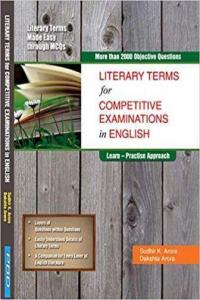Creation and Criticism
ISSN: 2455-9687
(A Quarterly International Peer-reviewed Refereed e-Journal
Devoted to English Language and Literature)
Vol. 05, Joint Issue 18 & 19 : July-Oct 2020

Book Review
Literary Terms Made Easy through MCQs by Sudhir K. Arora and Dakshta Arora
Sudhir K. Arora & Dakshta Arora. Literary Terms for Competitive Examinations in English (Literary Terms Made Easy through MCQs). Bareilly: Prakash Book Depot, 2020. Pp. 264 (Paperback). Rs. 280/-. ISBN: 978-81797-765-99
Reviewed by Abnish Singh Chauhan
Literary Terms for Competitive Examinations in English (Sub-title: Literary Terms Made Easy through MCQs) is an exquisite and encyclopedic work of literary terms along with mythical and biblical allusions, serious authors and their significant works, useful quotations, and some other remarkable interconnected facts of English literature.
The magisterial book, deftly written by one of India’s foremost literary scholars— Sudhir K. Arora and one of India’s Gold Medalists (Postgraduate in English) of 21st century— Dakshta Arora and exquisitely published by one of India’s leading publishers— PBD, Bareilly, is a rich collection of “knowledge-packed pieces of information” in the MCQs form for the lovers of English literature as well as for the aspirants of competitive examinations held around the world. Now the question may arise— what is the use of MCQs in understanding literary terms? The answer to this question is given by the authors themselves: “A multiple-choice question (MCQ) in this book is not simply a question but it has various pieces of information. You are not expected just to respond to the particular question. What is expected from you is the learning of the pieces of information after proper decoding" (ix).
Many a time, ‘decoding’, a skill for learning useful things, is found difficult for grasping and remembering what has been read from the text. But, this theory is not applicable to this handy book as it is written in the most suitable language using good, clean and comprehensive codes. Therefore, in chapter one— “Base: Essential Literary Terms”, the reader may easily understand the desired literary terms from ‘Ab ovo’ to ‘Zoomorphism’ including almost all the essential aspects of literature in descriptive question and answer form. Chapter two— “Structure: More Literary Terms” focuses on structural formation of various literary terms in order to turn words, phrases and sentences into a cohesive story. Turning all that raw contents into an innovative and perceptible form is not so easy a task. For example, Q.1298— “Four most common Rhetorical Modes of Communication or Modes of Discourse which describe the variety, conventions, and purposes are” — Ans.: c.— “narration, description, exposition, and argumentation” (wrong options are not pasted here). Chapter three— “Superstructure: Mythical and Biblical Allusions” presents some popular references of Greek or Roman mythology, the Bible and other historical figures of literature. This section of the book will help the readers to determine why ‘Hermes’ is the ancient Greek god, why ‘Jupiter’ is called Zeus or why ‘Nike’ is known as the goddess of victory?
The writers of the book do not forget to recognize the contribution of authors and the excellent role of literary journals of English literature. Hence, the chapter four— “Architects: Authors, Works and Journals” explores major works, popular authors and the literary media houses from the historical point of view. Chapter five— “Quotations: Creation and Criticism” embodies exact words of the creative writers as found in oral or written form of literature. For example, Q.2080— “A well-written life is almost as rare as a well-spent one. Whose statement is it?” — Ans.: c.— “Carlyle” (wrong options are not pasted here).
The book has also covered four appendices, namely— “Appendix 1: View: A Capsulized Sketch of Some Literary Terms”, “Appendix 2: Stream: Some Basic Facts from English Literature”, “Appendix 3: Recognition: Known For and Known As” and “Appendix 4: Treasure: Some Creative and Critical Books.” The appendices, which are helpful in imparting complete understanding of the literary terms, encompass additional facts and figures which are too descriptive to be comprised in the question and answer form.
Last but not least, the book, which successfully captures more than 2000 MCQs on literary terms and other interrelated facts of literature, is a kind of unique chronicle systematically composed in simple and clear expression in order to make the scholars understand even the most complex and methodical contexts of English literature with the help of guidelines as given in the beginning of the book— “How to Use the Book” and “Blueprint— the Dashboard.” Kudos! to the writers and the publisher for the remarkable work.
 About the Reviewer:
About the Reviewer:
Dr Abnish Singh Chauhan (1979), the editor of two online journals– Creation and Criticism and IJHER and a Hindi magazine– Poorvabhas, is presently serving as a Professor and Principal, BIU College of Humanities & Journalism, Bareilly International University, Bareilly. He has authored a number of books including Swami Vivekananda: Select Speeches, Speeches of Swami Vivekananda and Subhash Chandra Bose: A Comparative Study, The Fictional World of Arun Joshi: Paradigm Shift in Values and Tukda Kagaz Ka (A collection of Hindi Lyrics). He can be contacted at abnishsinghchauhan@gmail.com.

